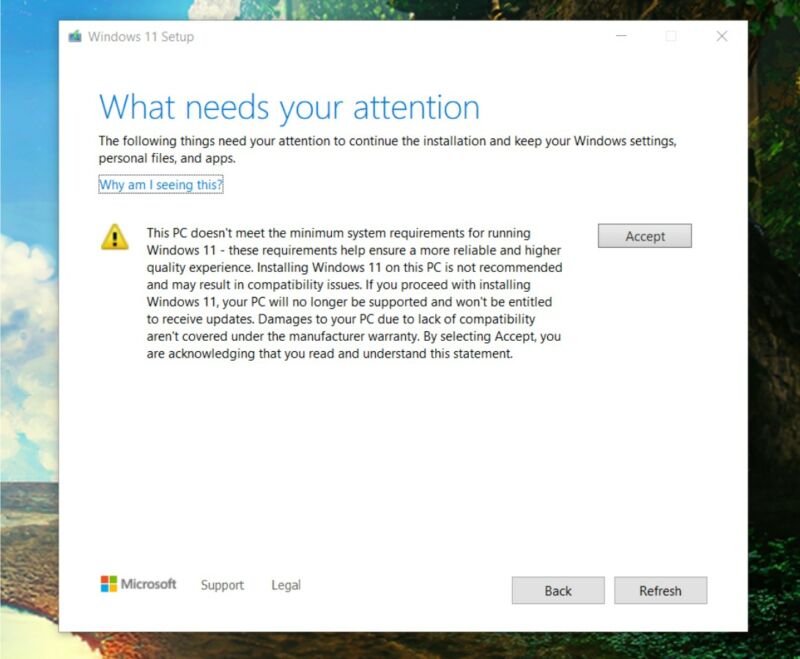
Officially, running Windows 11 will require a newer PC that meets all of the operating system’s performance and security requirements. Unofficially, running Windows 11 without meeting those requirements will be possible, but we still don’t know much about the details—how difficult it will be to install Windows 11 on those machines, how frequently they will remind you that you’re running on unsupported hardware, and even whether they’ll receive normal Windows security updates.
The Verge has spotted an apparently new warning message in the Windows 11 Setup app that explicitly warns users of the dangers of installing Windows 11 on unsupported hardware—you may run into “compatibility issues,” your PC “won’t be entitled to receive updates,” and that “damages to your PC due to lack of compatibility aren’t covered under the manufacturer warranty.” This is all stuff that we’ve heard from Microsoft before, but it’s the first time that this policy has appeared during the Windows 11 setup process rather than in media reports. Once you click through this foreboding warning message, the Windows 11 installation is apparently allowed to proceed.
I’ve tried and failed to recreate this screen on multiple unsupported Windows 10 systems of different vintages, both with builds downloaded through the Insider program and installs directly from a manually downloaded Windows 11 ISO file. I also haven’t seen any firsthand reports of it outside of the Verge report. This doesn’t mean it isn’t happening—Microsoft is always rolling out different updates to different groups of people at different times—just that I can only speculate as to when you will actually see this message and what it means.
My guess is that it is eventually intended to replace another screen currently shown when you attempt a manual install of Windows on an unsupported system, one that totally blocks the upgrade if you don’t meet Windows 11’s processor, TPM, or Secure Boot requirements. The only way to get around that screen and proceed with installation for current builds of Windows 11 is to implement some registry edits that disable the system checks. This new screen would keep the checks in place while allowing people to perform the kind of manual, officially unsupported installs that the company has begrudgingly decided to allow.

The setup screen that currently blocks Windows 11 installs on unsupported systems.
Andrew Cunningham
Officially supported or not, there are plenty of PCs released between 2015 and 2017 that should be able to run Windows 11 more-or-less as reliably as officially supported systems. The sixth- and seventh-generation Intel Core processors and first-generation AMD Ryzen processors still get modern driver updates from Intel and AMD, one of the key factors Microsoft cites when playing up Windows 11’s stability on newer computers. These PCs also remain perfectly capable of just about any modern PC workload short of high-end gaming or video editing, things that do actually benefit from newer CPUs and GPUs with more cores and higher clock speeds.
We’ll cover what it’s like to run Windows 11 on unsupported systems as part of our review coverage of the OS, so enthusiasts and testers at least have some idea of what they’re getting into. Windows 11 officially releases to the public on October 5. An updated version of Microsoft’s PC Health Check app that was recently released to the public can tell you more about whether your system meets the Windows 11 requirements and what (if anything) you can do to fix it.
Listing image by Andrew Cunningham



